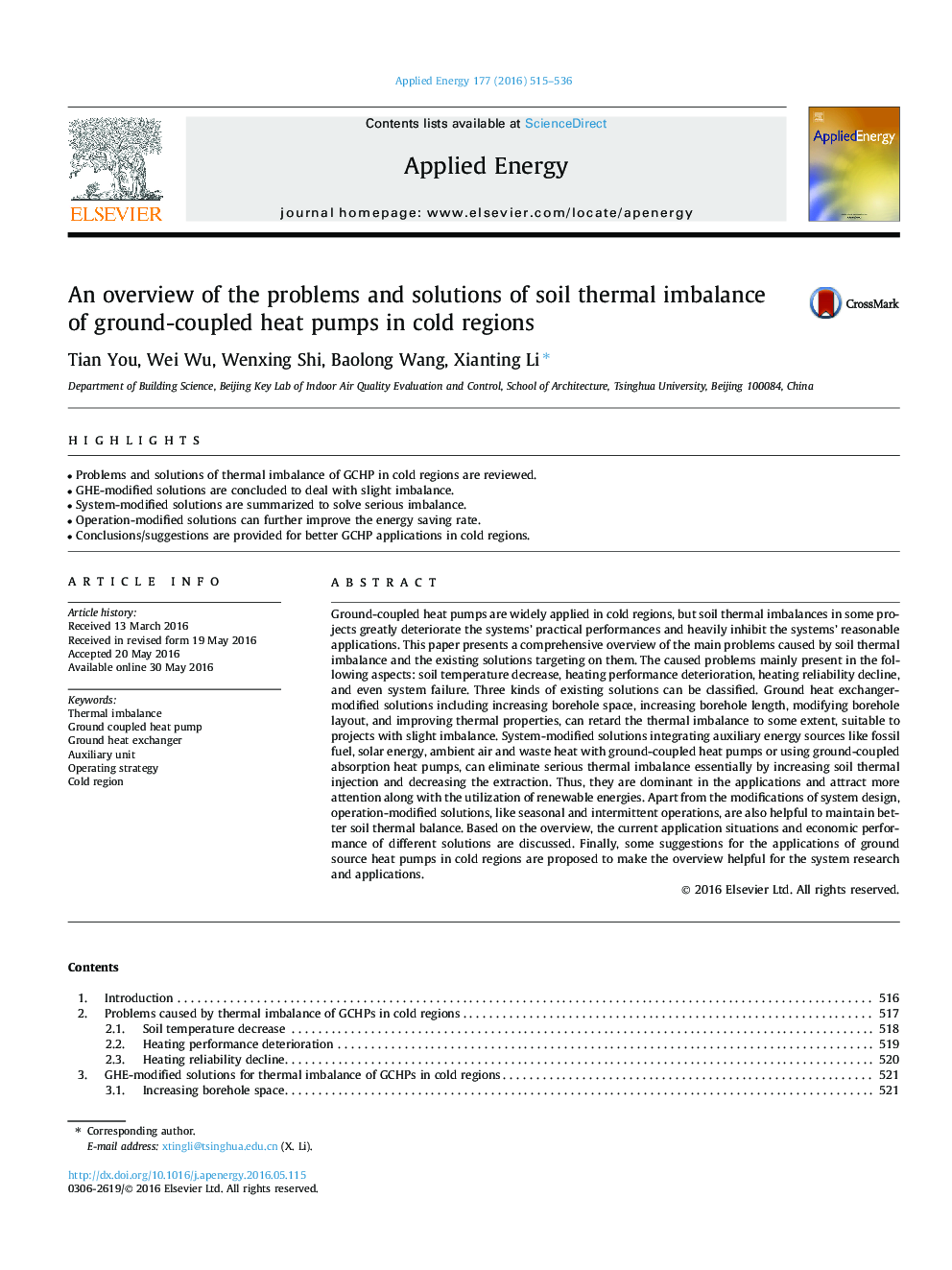| کد مقاله | کد نشریه | سال انتشار | مقاله انگلیسی | نسخه تمام متن |
|---|---|---|---|---|
| 6682749 | 501851 | 2016 | 22 صفحه PDF | دانلود رایگان |
عنوان انگلیسی مقاله ISI
An overview of the problems and solutions of soil thermal imbalance of ground-coupled heat pumps in cold regions
ترجمه فارسی عنوان
یک مرور کلی از مشکلات و راه حل های عدم تعادل حرارتی خاک پمپ های حرارتی زمین در مناطق سرد
دانلود مقاله + سفارش ترجمه
دانلود مقاله ISI انگلیسی
رایگان برای ایرانیان
کلمات کلیدی
عدم تعادل حرارتی، پمپ حرارتی همراه، مبدل حرارتی زمینی، واحد کمکی، استراتژی عملیاتی، منطقه سرد،
ترجمه چکیده
پمپ های حرارتی متصل به زمین به طور گسترده در مناطق سرد استفاده می شود، اما عدم تعادل گرما در برخی از پروژه ها عملکرد عملیات سیستم ها را به شدت کاهش می دهد و به شدت مانع از برنامه های کاربردی مناسب سیستم می شود. این مقاله یک مرور کلی از مشکلات اصلی ناشی از عدم تعادل حرارت حرارتی و راه حل های موجود برای آنها ارائه می دهد. مشکلات ایجاد شده به طور عمده در جنبه های زیر وجود دارد: کاهش درجه حرارت خاک، کاهش درجه حرارت، کاهش قابلیت اطمینان حرارت، و حتی شکست سیستم. سه نوع از راه حل های موجود را می توان طبقه بندی کرد. راه حل اصلاح شده مبدل های حرارتی زمین از جمله افزایش فضای گمانه، افزایش طول گمانه، اصلاح چاه گهواره و بهبود خواص حرارتی، تا حدی می تواند عدم تعادل حرارتی را کاهش دهد، مناسب برای پروژه هایی با عدم تعادل کم. راه حل های اصلاح شده سیستم که یکپارچه سازی منابع انرژی کمکی مانند سوخت فسیلی، انرژی خورشیدی، هوای محیط و حرارت زیست محیطی با پمپ های حرارتی متصل به زمین یا استفاده از پمپ های حرارتی جذب زمین می باشد، می تواند عدم تعادل جدی حرارتی را از طریق افزایش تزریق گرما و کاهش استخراج . بنابراین، آنها در برنامه ها غالب هستند و توجه بیشتری را به همراه استفاده از انرژی های تجدید پذیر جذب می کنند. به استثنای تغییرات طراحی سیستم، راه حل اصلاح شده عملیاتی مانند عملیات فصلی و متناوب نیز برای حفظ تعادل حرارتی بهتر خاک مفید است. بر اساس مرور، شرایط برنامه فعلی و عملکرد اقتصادی راه حل های مختلف مورد بحث قرار می گیرد. در نهایت، بعضی از پیشنهادات برای استفاده از پمپ های حرارتی زمین در مناطق سرد پیشنهاد می شود که کلیه اطلاعات مورد نیاز برای تحقیق و کاربرد سیستم را ارائه دهند.
موضوعات مرتبط
مهندسی و علوم پایه
مهندسی انرژی
مهندسی انرژی و فناوری های برق
چکیده انگلیسی
Ground-coupled heat pumps are widely applied in cold regions, but soil thermal imbalances in some projects greatly deteriorate the systems' practical performances and heavily inhibit the systems' reasonable applications. This paper presents a comprehensive overview of the main problems caused by soil thermal imbalance and the existing solutions targeting on them. The caused problems mainly present in the following aspects: soil temperature decrease, heating performance deterioration, heating reliability decline, and even system failure. Three kinds of existing solutions can be classified. Ground heat exchanger-modified solutions including increasing borehole space, increasing borehole length, modifying borehole layout, and improving thermal properties, can retard the thermal imbalance to some extent, suitable to projects with slight imbalance. System-modified solutions integrating auxiliary energy sources like fossil fuel, solar energy, ambient air and waste heat with ground-coupled heat pumps or using ground-coupled absorption heat pumps, can eliminate serious thermal imbalance essentially by increasing soil thermal injection and decreasing the extraction. Thus, they are dominant in the applications and attract more attention along with the utilization of renewable energies. Apart from the modifications of system design, operation-modified solutions, like seasonal and intermittent operations, are also helpful to maintain better soil thermal balance. Based on the overview, the current application situations and economic performance of different solutions are discussed. Finally, some suggestions for the applications of ground source heat pumps in cold regions are proposed to make the overview helpful for the system research and applications.
ناشر
Database: Elsevier - ScienceDirect (ساینس دایرکت)
Journal: Applied Energy - Volume 177, 1 September 2016, Pages 515-536
Journal: Applied Energy - Volume 177, 1 September 2016, Pages 515-536
نویسندگان
Tian You, Wei Wu, Wenxing Shi, Baolong Wang, Xianting Li,
